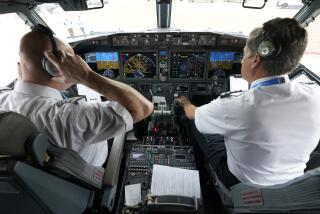Views on Airline Training Are Hit
In the article on former test pilot LeVier, there are a couple of statements I feel compelled to challenge. One is that âunder current FAA regulations, pilots are taught to avoid emergencies, but they are not required to learn how to stabilize an aircraft that is out of control.â This is apparently a reference to the fact that the Federal Aviation Administration does not require âspin training,â which is a different matter. Student pilots, whether for private, instrument or commercial ratings, are constantly being given âunusual attitude recoveryâ training.
We who fly are forever aware of the vagaries of weather, turbulence and mechanical malfunction (however rare). This unusual attitude recovery training specifically requires us to learn how to stabilize an out-of-control aircraft. The story also said that while pilots âare taught to recognize the onset of a stall, they do not learn techniques to recover from a full stall.â
Absolutely incorrect. The FAA specifically requires full-stall training in three regimes: power on, power off and accelerated stalls. The idea is to teach a pilot how to avoid going into a spin, which can occur if the aircraft is significantly mishandled during stall recovery. I agree with LeVier that spin training should be required, and any pilot worth his salt (and any instructor) includes it in training.
WAYMAN C. DUNLAP
Editor/Publisher
Pacific Flyer Aviation News
Vista, Calif.
Editorâs Note: LeVier feels that existing stall training provides for recovery far too early in a stall to teach students how to cope with an emergency situation. Similarly, he contends, most spin training is rudimentary and does not expose student pilots to the violent gravitational forces of an actual emergency.
More to Read
Sign up for The Wild
Weâll help you find the best places to hike, bike and run, as well as the perfect silent spots for meditation and yoga.
You may occasionally receive promotional content from the Los Angeles Times.






